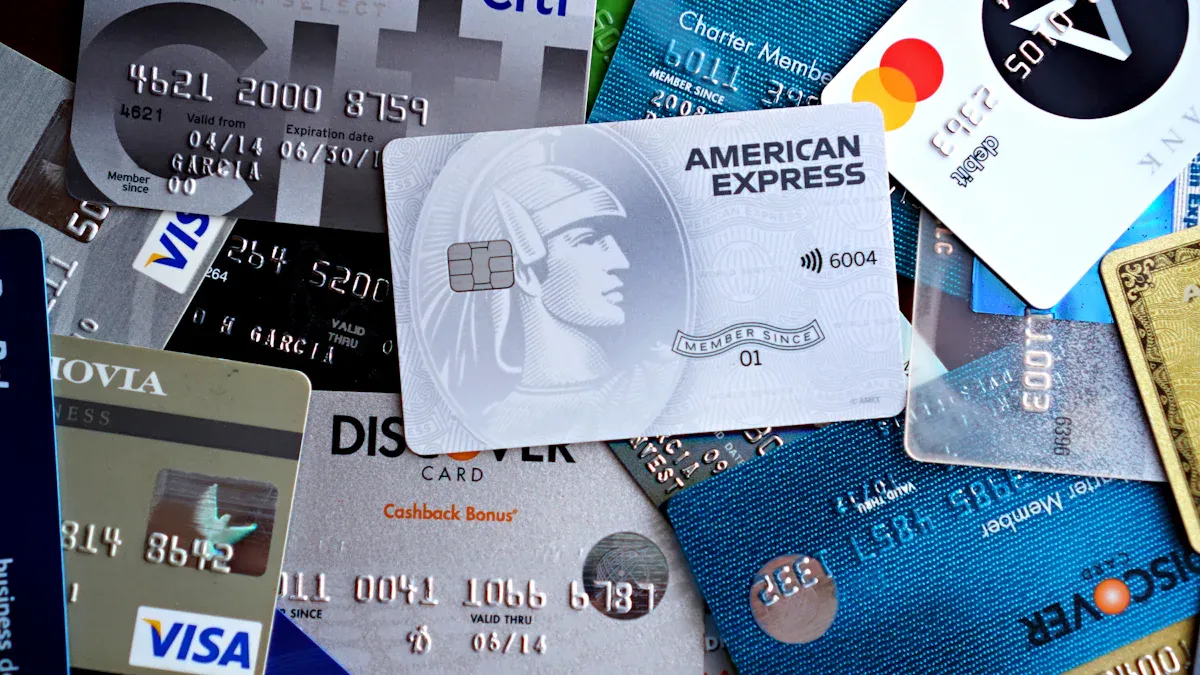- EasyCard
- Trade
- Help
- Announcement
- Academy
- SWIFT Code
- Iban Number
- Referral
- Customer Service
- Blog
- Creator
What important information should be noted when making a transfer with American Express?

Image Source: unsplash
Using American Express for transfers is very convenient, but you need to first focus on three core issues. They are: fees and exchange rates, arrival time, and recipient eligibility. These factors directly determine the cost and efficiency of your transfer.
Before transferring, please think first: Does your operation comply with Amex requirements? Are you clear about how much extra fees you need to pay?
Clearly understanding this information can help you make wiser decisions and ensure every fund flow is safe and controllable.
Key Points
- Before transferring, you need to understand fees, arrival time, and recipient eligibility.
- American Express transfers often go through third-party platforms, resulting in multiple fees and exchange rate margins.
- Transfer speed is affected by various factors; international transfers usually take longer.
- Both you and the recipient must comply with American Express regulations and provide accurate information.
- Protect personal information, be vigilant against scams, and ensure fund security.
Analyzing Transfer Fees and Exchange Rates

Image Source: unsplash
Before delving into the fees of American Express transfers, you first need to understand a key point: American Express’s personal transfer functions, such as “Send & Split,” usually require linking to third-party payment platforms like PayPal or Venmo to complete. Therefore, the fees you need to pay may come from multiple sources.
How Handling Fees Are Calculated
The calculation of handling fees depends on your payment method. Fees mainly come from two aspects:
- Third-Party Platform Fees: When you transfer to friends and family via PayPal using an American Express card, this transaction is treated as a credit card payment. PayPal usually charges a fee for this, for example, in the US, the fee is 2.9% + $0.30 fixed fee.
- American Express Card Fees: In some cases, American Express may treat transfers through third-party platforms as “Cash Advances.” Cash advances not only incur higher fees but also start accruing interest from the transaction day, significantly increasing your costs.
Hidden Costs of Exchange Rates
If you are making an international transfer, the exchange rate is an important hidden cost. The exchange rate provided by the platform is usually higher than the interbank mid-market rate, and this difference is the platform’s profit.
How to Query and Compare Exchange Rates?
The American Express Rate used by American Express is usually close to the mid-market rate but is not publicly available like Visa or Mastercard. You can:
- Log in to your Amex App or online account and use its calculator to view real-time exchange rates.
- Before transferring, use tools like Google, XE, or Wise to query the current mid-market rate and compare it with the rate provided by Amex to understand the actual cost.
Associated Platform Fees
Associated platform fees are an important part of the total cost, especially for international transfers. Taking PayPal as an example, the fee structure for international transfers using a credit card is far more complex than domestic transfers. In addition to standard credit card fees, there is usually an additional international transfer fee (for example, 5%, with minimum and maximum caps) and currency conversion fee.
To give you a clearer understanding of the fee structure, please refer to the table below:
| Fund Source | Domestic US Transfer Fees | International Transfer Fees |
|---|---|---|
| American Express Card | 2.9% + $0.30 fixed fee | 2.9% + fixed fee + 5% international fee + currency conversion markup |
| Bank Account Balance | Usually free | May charge international fee + currency conversion markup |
Before confirming the transfer, be sure to carefully check all fee details on the final payment page.
Understanding Transfer Speed and Influences
In addition to fees, transfer speed is also a factor you need to focus on. Whether funds arrive on time directly affects your plans. The speed of American Express transfers is influenced by various factors; understanding these can help you plan better.
Standard and Expedited Arrival Times
Transfer speed mainly depends on whether funds are flowing domestically or internationally in the US. Generally, international transfers take longer due to bank regulations, time zone differences, and currency conversion processes.
| Transfer Type | Estimated Processing Time |
|---|---|
| Domestic US Transfer | Usually processed quickly if submitted before cutoff time |
| International Transfer | May take 1-3 business days, sometimes even longer |
Key Factors Affecting Speed
Various situations may cause your transfer to be delayed. The most common reasons include security verification and information errors.
- Security Verification Process:
- Multi-Factor Authentication: The system may require you to confirm identity via one-time password or biometrics.
- Suspicious Activity Monitoring: If the system detects transactions that do not match your usual patterns, the transfer may be paused for verification.
- Incomplete Information Provided:
- Recipient Information Errors: Incorrect name, bank account number, SWIFT/BIC code, or address is the primary cause of delays.
- Missing Proof Documents: For large transfers, you may need to provide proof of fund source or transaction purpose.
Impact of Holidays and Weekends
Please note: Banks and payment systems usually do not process transactions on holidays and weekends. If you initiate a transfer during these times, the processing will be postponed to the next business day.
To ensure funds arrive on time, try to operate on business days and leave enough buffer for potential delays.
How to Track Transfer Status
Want to know where your funds are? You can track transfer progress in the following ways:
- Log in to your Amex App or online account to view status updates in transaction history.
- Check transaction details on your associated third-party platform (such as PayPal).
- Pay attention to your registered email; American Express or related platforms usually send status notifications via email.
American Express Transfer Eligibility and Limits

Image Source: pexels
Before starting a transfer, you must ensure that both you and the recipient meet American Express’s eligibility requirements. Understanding these limits can help you avoid unnecessary trouble and transaction failures.
Requirements for the Sender
As the sender, you need to meet some basic conditions. These conditions ensure the legality and security of the transaction.
- You must hold a valid American Express card.
- Your account needs to be in good standing without overdue payments.
- You must be able to pass American Express’s security verification process.
Requirements for the Recipient
The recipient also needs to meet specific conditions, the most critical being their geographic location.
Important Tip: American Express’s transfer service does not cover the globe. You need to confirm whether the recipient’s country or region is within the supported service range. For example, transfers to bank accounts in certain regions (such as Hong Kong) are feasible, but not all countries are supported.
Additionally, the recipient needs to have a valid receiving channel, such as a PayPal account, Venmo account, or eligible bank account.
Key Information Required for Transfers
Providing accurate information is the cornerstone of a successful transfer. Information errors are the most common cause of delays or failures.
- Transfers to Bank Accounts: You must prepare the recipient’s Account Number and Routing Number.
- Transfers to Third-Party Platforms: You usually need the recipient’s registered email or phone number.
Special Situation Reminder: If you transfer funds out from an Amex High Yield Savings Account, you may encounter a “y-vol” withdrawal limit. In this case, you need to contact customer service in advance to request temporary removal of the limit to transfer smoothly.
Various Transfer Limits
American Express transfers have different types of limits, including per-transfer amount caps and transfer restrictions between card types.
First, you need to understand transfer rules between different card types:
| Card Type | Transfer Direction | Allowed Transfer |
|---|---|---|
| Personal Card | Between Personal Cards | Yes |
| Business Card | Between Business Cards | Yes |
| Personal Card | Business Card | Yes |
| Business Card | Personal Card | No |
In addition to the above rules, your account will have daily, weekly, or monthly total amount limits. You can view your specific limits in the Amex App or online account.
Ensuring Fund Transfer Security
Fund security is the top priority in the transfer process. American Express has multiple security measures to protect your account, but you also need to understand and take action to prevent potential risks.
Official Fraud Protection Policy
American Express provides fraud protection policies for its cardholders. If you discover unauthorized transactions on your account, contact customer service immediately. Official channels can provide investigation and handling support, which is the first line of defense for securing your funds.
Identity Verification Process
To confirm that it is you operating, American Express adopts a multi-factor identity verification process. These security measures are designed to prevent unauthorized access. Common verification methods include:
- Account Password and Security Certificate (SSL): This is the basic verification for login and payment.
- One-Time Verification Code: The system sends a code to your mobile SMS or registered email for confirming key operations.
- 3D Secure Authentication: During online payments, the system may require additional verification to enhance transaction security.
Preventing Common Transfer Scams
Scam methods are becoming more sophisticated, and you need to stay highly vigilant. Recently, a phishing scam targeting American Express holders has become very common.
Beware of Fake Security Emails!
Scammers send emails disguised as “Amex Security Help Desk” with subjects usually like: “Your American Express account needs immediate verification.” These emails may include the last five digits of your card number and have no spelling errors, looking very real. The email falsely claims your account is restricted and induces you to click a link to “verify” identity.
Never click such suspicious links. The scammers’ ultimate goal is to steal your full card number, password, Social Security number, and other key personal information.
Protecting Personal Sensitive Information
Protecting your personal information is key to preventing fraud. Please be sure to follow these security guidelines:
- Verify Official Channels: Always log in to your account through the official app or website, not through links in emails or SMS.
- Never Share Verification Codes: Banks or American Express will never ask you for received verification codes.
- Set Strong Passwords: Set a complex password for your account containing letters, numbers, and symbols.
- Be Vigilant Against Requests for Information: Any behavior requesting your full card number, password, or security code is highly likely to be a scam.
By following these simple security habits, you can add a solid security barrier to your American Express transfer operations.
Before your American Express transfer, be sure to carefully check fees, exchange rates, arrival time, and eligibility limits. This can help you avoid unnecessary expenses and delays.
Final Pre-Transfer Checklist
- Confirm the total fees to be paid.
- Check the final exchange rate used for the transaction.
- Verify recipient information, especially Account Number and Routing Number.
- Understand the expected fund arrival time.
- Confirm the transfer amount does not exceed your account limits.
After fully understanding this key information, you can complete every operation more confidently and efficiently.
FAQ
How to avoid transfers being treated as “Cash Advances”?
The most effective way is to avoid directly using an American Express credit card for transfers. You can first transfer funds from an associated bank account to PayPal or Venmo balance, then use the balance for payment. This usually does not incur cash advance fees.
To which countries or regions’ bank accounts can I transfer?
American Express’s international transfer service does not cover all countries. For example, you can transfer to bank accounts in certain Hong Kong regions. It is recommended to query the latest supported country list through the Amex official app or website before transferring.
What if my transfer fails?
The most common reason for transfer failure is recipient information errors. Please immediately check if the entered Account Number and Routing Number are completely accurate. After confirmation, you can try to re-initiate the transfer.
Where can I view all transfer fees?
All fee details will be clearly listed on the final confirmation page. Before clicking “Confirm Transfer” or “Send,” be sure to carefully check all fees displayed on that page, including handling fees and costs due to exchange rates.
*This article is provided for general information purposes and does not constitute legal, tax or other professional advice from BiyaPay or its subsidiaries and its affiliates, and it is not intended as a substitute for obtaining advice from a financial advisor or any other professional.
We make no representations, warranties or warranties, express or implied, as to the accuracy, completeness or timeliness of the contents of this publication.




Contact Us
Company and Team
BiyaPay Products
Customer Services
is a broker-dealer registered with the U.S. Securities and Exchange Commission (SEC) (No.: 802-127417), member of the Financial Industry Regulatory Authority (FINRA) (CRD: 325027), member of the Securities Investor Protection Corporation (SIPC), and regulated by FINRA and SEC.
registered with the US Financial Crimes Enforcement Network (FinCEN), as a Money Services Business (MSB), registration number: 31000218637349, and regulated by FinCEN.
registered as Financial Service Provider (FSP number: FSP1007221) in New Zealand, and is a member of the Financial Dispute Resolution Scheme, a New Zealand independent dispute resolution service provider.




















